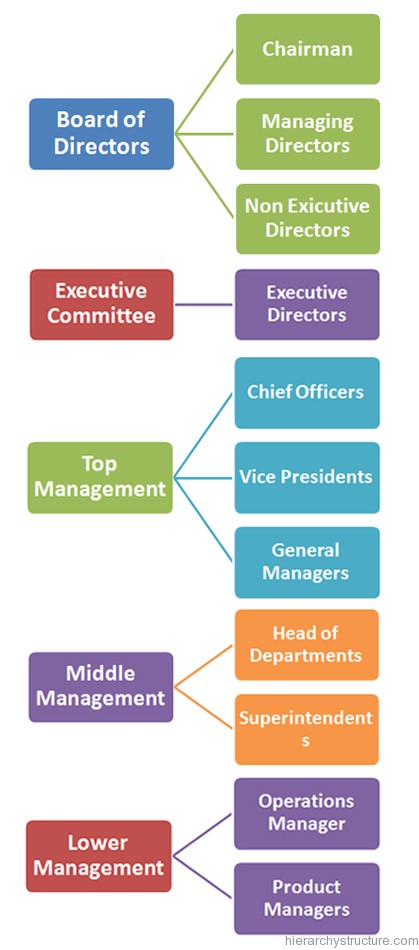Business organization hierarchy refers to the hierarchical or pyramidal structure of the organization that delegates the business functions, business activities, business processes and the employees in multiple vertical and lateral levels. In such organizations, power and authority are delegated downwards beginning at the top, from each manager to his subordinate. Each position has a complete sphere of operation. Following are the different levels of business organization hierarchy:

Board of Directors
The board of directors is a group of shareholders of the organization. The board is the supreme policy framing and decision making body in the organization, that is in charge of the overall supervision and control of the affairs of the enterprise.
Executive Committee
Next to the board of directors in the hierarchy, we have the executive or working committee of a few directors to transact business more quickly. It usually transacts the urgent business. It also funnels matters for board consideration and decision. The other directors usually accept a proposal from the executive committee.
Top Management
The board appoints the chief executive officer (CEO), who is delegated the task of running the entire business. Apart from the CEO, there are some other officers at this level that include Chief Officers, Vice Presidents, General Managers or Divisional Managers to assist the chief executive. This small body of executive officers constitutes the top management and is in charge of all managerial functions and power. Their job responsibilities include policy framing, determination of short & long term goals and objectives, formation of plan to carry out objectives and policies, and building up organizational framework for executive plans.
Middle Management
Similarly, the top management in turn re-delegate their subordinates, for example, departmental managers. This is a large group of managerial level professionals consisting of Head of Departments and superintendents. They are the assistants to the senior executives and act as their deputies. Middle management includes heads of specialized sections. Coordination is the central issues in the organizations and middle management provides the key people in achieve g effective coordination upwards, downwards and sideways in the business organization hierarchy.
Their job responsibilities also include mobilization of resources to implement the plans, motivating personnel for effective performance through appropriate leadership, and controlling operations to ensure realization of set goals or objectives.
Lower Management
At the bottommost level of this hierarchy, lies the lower management, also called supervisory management constituting of supervisors and lower level managers. Lower management puts the plans of the management into effective actions, allocating individual work and seeing that it is getting accomplishes as per schedule. They are also required to oversee the day today tasks of the organization. It is a large group of first line supervisors and their managers at the lower levels are the direct in charge of the operatives or the employees. They handle specialized sections or departments in the organization, and their scope of work is limited to the effective management of their particular department.
